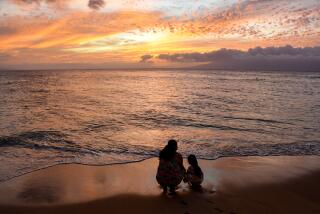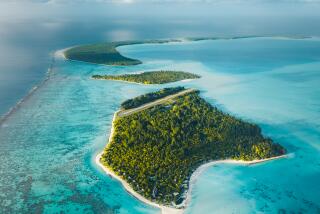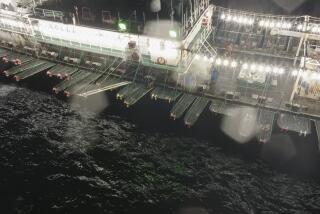MANIHI: Island : A TINY DROP OF LAND IN THE SOUTH PACIFIC IS THE POLYNESIA OF LEGEND.
- Share via
MANIHI ISLAND — Like a coral necklace dropped from the sky, Manihi, the farthest atoll in the South Pacific Tuamotus Archipelago, is the Polynesia of romantic myth. Until recently it was isolated from the outside world, known to few besides the people who were born at Paumotu, the island’s one small village.
Treasure lies within the circlet of this reef, for a quirk of nature has made the floor of the lagoon the breeding ground of the only oysters in the world that bear black pearls.
My husband and I were on one of our visits to Tahiti when a friend suggested that we visit Kaina Village, a 16-bungalow resort in the Tuamotus, on the private island of Manihi owned by Coco Chaze. He contacted Coco, a French pearl-farming entrepreneur on Manihi, 335 miles northeast of Papeete. We took off on Air Tahiti’s two-hour flight to Manihi.
Tehau, my Tahitian seatmate, like most of the passengers, was returning home from his job in Papeete. He was so loaded with gifts that he seemed to overflow the seat.
Most packages held meat because there is no way to graze animals for food on the atoll, and few of Manihi’s residents can afford to import food from Papeete. He said that in Tahiti he had learned that “it is good for children to have something other than fish in their diet.”
Our seats were near the open luggage compartment where he watched his crate of chicks valiantly trying to get out. I watched them too, ready to pounce on the lid with him, as their heads and legs emerged with each bounce of the plane. Fortunately, the flock arrived intact so his mother was able to start a chicken farm and share eggs with her neighbors.
The Manihi runway is a sliver of land, the roaring ocean on one side, the lagoon we were to come to know so well on the other. We were taken to Kaina in the motor-driven canoe that was to be our transportation for the remainder of our stay.
Like all atolls the land is flat, formed from islands that were once submerged, now covered with palms and lush tropical greenery. Beaches are mere threads of sand, fringed with coral and dotted with shells. The Pacific breaks in giant waves against the rim of this narrow strip of land. Goelettes, the 24-foot inter-island trading vessels that until recently were the atoll people’s only contact with the outside world, brave rough currents at the pass into the lagoon to collect their cargoes of mother-of-pearl shells.
Kaina Village is well-named. Tahitian country folk are affectionately spoken of as Kainas. Paumotu’s Kainas quickly became our friends and we adapted to their simple pleasures and the tempo of village life.
Our over-water bungalow, with every modern convenience, seemed an anachronism in these primitive surroundings. Schools of golden fish swam beneath our balcony in water so clear that we saw them as in an aquarium. The temptation was to wallow in relaxation, just watching the greens and blues of the sea merge into the sky. Instead, we dived into the water and followed the fish into their depths.
Their feeding grounds were the gardens of the lagoon, the beds of coral that were a medley of greens, pinks, mauve and orange. Giant shells opened and closed before our eyes, starfish and living sponges dotted the sand, and a ballet of iridescent angelfish--sapphire blue and striped with gold--danced among lacy madrepores. Fish, whose bodies seemed spawned from rainbows, peered into our masks and swam within our grasp.
Tahitian Hostess
Mareva Coquille, our Tahitian hostess, operated Kaina like a private home, getting congenial couples together in the over-water bar, the game room and in the thatched-roof dining hall which, like a museum devoted to ancient seafarers, was dominated by a great New Guinea war canoe.
We were served family-style at a table we shared with a couple from Pomona, a businessman from Buenos Aires and a prosperous Tahitian family who brought their daughter to show her what Tahiti was like when they were children, only to find that she was more interested in asking American visitors if they knew her favorite rock stars.
Steaming bowls of French, Chinese and Polynesian delicacies were brought to our tables, each dish so delicious that we wished our own spice cabinets held the fresh vanilla and delicate herbs that went into Mareva’s recipes.
During the evenings, villagers came to strum guitars and entertain us with melodies that had been passed down through generations. When they swung into “Kaina Village in Manihi,” Coco told us that the funny song had been a favorite on the “Tahitian Hit Parade.”
Fishing and Snorkeling
Each morning we went snorkeling. Our motor-driven canoe sped over the lagoon and dropped anchor at a coral shoal. The men fished with spear guns, aiming them with deadly accuracy.
One of the fishermen swam toward a brilliant blue fish. He shot and pierced the fish with the arrow-like point of his gun. I’ve fished all my life, and always thought of it as a harmless sport, a good catch for food and a big one to brag about. Spearing seemed different. Was it that the fish in these waters were so tame? So gloriously beautiful?
Perhaps it was the selectivity that I was unaccustomed to, for when I returned to the boat, to the Tahitian boatman who was fishing with just a drop line, I felt that I was once more in my own element. He baited a hook for me with a bit of the mollusk he’d picked off the reef. Offering me a bite, he swallowed the rest. I agreed that it was delicious, and so did the fish who grabbed my line as fast as I threw it over.
Circling Sharks
Watching from my perch on the boat I suddenly became frightened. Two sharks were circling nearby swimmers and there was blood from the speared fish in the water. I pointed to the sharks, wanting to find a way to warn the swimmers, but my Tahitian friend only laughed.
“Those sharks are not dangerous,” he said. “Why should they attack a man when so many fish swim within a snap of their jaws?” My fear dispelled, I dived in. Swimming with sharks was definitely an unexpected adventure.
It is impossible to ever be bored at Kaina. One morning, when the Argentine scuba divers took off, we joined a young couple from Rome and chartered a fishing boat with the skipper’s promise that we could catch either a blue marlin, mahi-mahi or yellow-fin tuna, and we returned joyously flying the marlin flag.
We picnicked on Ahe, a popular anchorage for international yachtsmen. Seeing an 80-foot ketch from Marina del Rey rolling with the waves was like a breath of home.
The Picnic Lunch
Lunch started with poisson cru --raw fish cut into bite-size pieces and marinated with onions and milk squeezed from grated coconut. After Mareva seasoned the rest of our fish with limes from the island’s trees, the barbecue began.
We could have done without poi, the staple of every Tahitian meal.
Across the lagoon we explored Puamotu Village, which is home to the Tahitians who work in the pearl industry. Seeing our boat pull up, a pack of scrawny dogs lost interest in old men playing boccie ball and trailed us to the village square where a large pool was filled with harmless nurse sharks that pearl divers consider a good omen. Young boys, killing time wrestling the sharks, got out when we arrived.
Walking up a “street” of sand, every limestone and clapboard house showed a pride of ownership with a few flowers in gardens of seashells. Old outhouses, built on stilts over the water’s edge, were a reminder of poorer days.
The Tahitian divers we met at the village were strapping men; we were told they could withstand the pressure of searching for oysters in up to 20 fathoms of water.
Around 1870 scientists were sent to the Tuamotus to study ways of cultivating the reproduction of oysters by improving their environment and thereby limiting the plunder of oyster beds that had gone on for more than 100 years.
Pearl Culture Farm
The first experimental pearl culture farm at Manihi was established in 1968 by Rosenthal Brothers, pearl merchants from France who used the technique that Mikimoto had evolved to create the cultured pearl industry in Japan.
We had been told about the oyster “hospital” but didn’t expect to find a complex “operating room” with sophisticated X-ray equipment. Each shell was placed in a vise and kept out of water until it opened. Then a tiny wooden wedge was inserted so that a mother-of-pearl bead, cut from the shell of a Mississippi River clam, could be slipped into the visceral mass of the oyster, creating the irritant that would cause a pearl to develop.
After surgery the oysters were guarded in an underwater recovery room and checked constantly to be sure that no disease-causing fungus had grown on their shells. When fully recovered, they were strung on lines at a depth of about 25 feet.
These are the only South Pacific oysters whose shells run the gamut of the color spectrum, causing the pearls they bear to inherit their coloration. Maps, identifying the location of the various hues, are kept meticulously. As well as being guarded like babes in a nursery, the oysters are frequently returned to the hospital and X-rayed to be sure that a pearl is developing. If a fourth of the oysters that have been seeded produce quality pearls, the harvest is considered successful.
A Look at Black Pearls
We canoed over the oyster beds and watched a diver swim to the pearl farm and pick two shells at random from what looked like an underwater fence. Returning to our boat, he opened them and we witnessed the birth of black pearls as they gently rolled from the body of the oysters that had produced them.
Each quality black pearl that I priced at Polynesie Perles at Vaima Center in Papeete cost several hundred dollars. Their value can only increase because the French government has placed a quota on the number of oysters that can be taken from the lagoon during a diving season.
Departure time came too soon. Our village friends paddled to the airport terminal, a simple thatched roof set on poles to shield travelers from the sun. One brought a lei, another a shell with the blister of a half pearl. They were our last glimpse of a way of life that may end all too soon. Polynesia is growing up.
-- -- --
Daily rates at Kaina Village are $120 per person, double occupancy, $160 single, including all meals; $95 with just breakfast and dinner. The deep-sea fishing boat can be chartered by four fishermen at $35 per person for the first hour and $30 per hour for the balance of time aboard.
Certified scuba divers may book five nights’ accommodations, double occupancy, at Kaina Village, including breakfast and dinner and four days’ diving (two tanks a day) at $770 each, through Sea Safaris, 3770 Highland Ave., Suite 102, Manhattan Beach 90266, phone (213) 546-2464 or (800) 821-6670.
Air Tahiti flies round trip, Papeete to Manihi, every Tuesday, Friday and Sunday for $340. Costs may vary slightly due to rates of exchange.
More to Read
Sign up for The Wild
We’ll help you find the best places to hike, bike and run, as well as the perfect silent spots for meditation and yoga.
You may occasionally receive promotional content from the Los Angeles Times.






